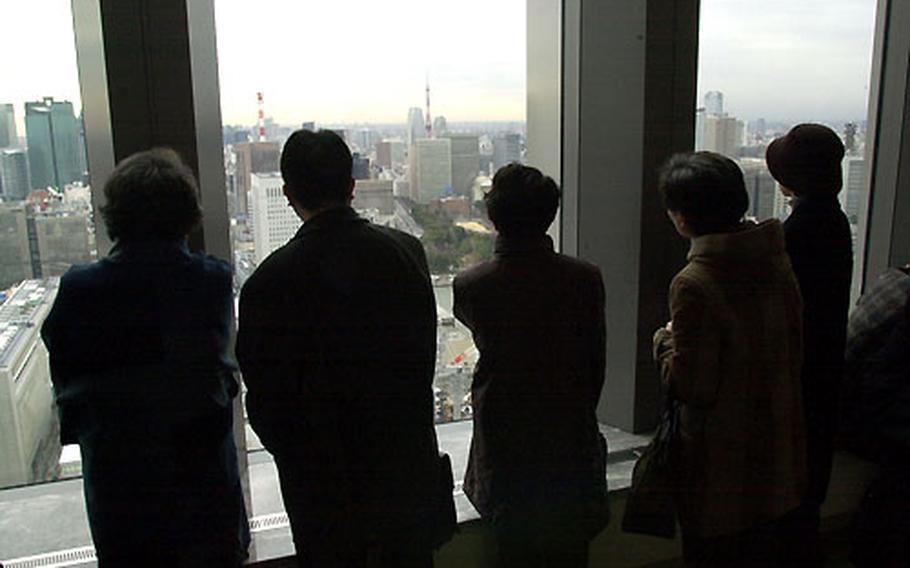
Many people enjoy the open spaces created for those conducting business activities on the upper floors and the views of Tokyo they afford, such as this one on the 26th floor. (Jim Schulz / S&S)
TOKYO — After strolling around the imperial garden, don’t rush home and miss another of Tokyo’s historic structures, one that has undergone a recent, dramatic change.
Two blocks from the imperial palace and across the street from the Tokyo station, stands the Marunouchi building, or as it’s commonly known, Maru biru. Recently rebuilt, it has become Tokyo’s new shopping mecca while retaining its name recognition.
In the effort to revitalize the business area that’s deserted on the weekends, big name shops have been lured to the Maru biru and surrounding area in hope of creating a new flavor for the business center of Tokyo.
As part of the revitalization project, the now-37-story Marunouchi building was rebuilt. The design incorporates the best of both the old and new buildings — the bottom retaining the character of the old building, which has been a landmark of the city since 1923.
The new part of the structure resembles an office building and shopping mall combined and rises like a phoenix from the old. It not only houses business offices but also more than 100 shops and restaurants. Since its opening in September, Maru biru has attracted more than 7 million visitors — a pretty impressive record for the first three months of operation.
Shops are on the first seven floors of the building and the basement floor sells take-out food such as soups and bagels as well as Starbucks coffee. Retail fashion stores for men and women with colorful window displays occupy most of the shopping floors. In addition, there are book, cosmetic, jewelry and music stores to peruse. Four floors, including the top two floors of the high-rise, are dedicated primarily to restaurants.
The first floor accommodates a high-ceilinged glassed atrium, giving the area a wide, airy atmosphere. It opens out to the newly established shopping streets of the Marunouchi area. In the atrium, small concerts and events are held and seasonal decorations and exhibits displayed.
Restaurant areas are separated into two categories. The lower floors offer casual eat-in restaurants with California cuisine, Chinese and Japanese restaurants to tempt all palates. Higher floors have eating areas which house Japan’s finest restaurants. They offer various types of International cuisine as well as showcasing spectacular, panoramic views of Tokyo.
Prices at the restaurants on the top floors are high but if you’re game and want to enjoy the views, you can take elevators up to enjoy fabulous dining and views out of the large windows. From the windows, visitors can take in views of Tokyo skyline, Tokyo Bay and the imperial palace.
Although most stores and restaurants in the building are Japanese and prices do tend to run high, Maru biru offers a glimpse into Japanese trends.
For more information and a list of shops, you can visit their Web site at www.marubiru.jp/index_e.html. There is also an information desk on the first floor that provides directions in English.
Maru biru: The floor story
The Marunouchi building’s 37 floors provide for great shopping, eating and a place to conduct business.
B1F: This floor has many unique shops that cater to the lifestyles of busy adults, including a variety of deli’s, bakeries and sweet shops, a florist, a post office, an ATM machine, a drug store, stores for men’s and ladies fashions, a convenience store and more.
1F: Housing the atrium, this main floor serves as a restful space and conduit to other floors and the local business/shopping district.
2F: Primarily filled with men’s and ladies retail shops, this floor also has the Marunouchi Cafe.
3F: Many unique shops sell clothes, jewelry, shoes and other accessories and items for the home.
4F: Other interesting outlets, such as a music store, nail and reflexology salon, greeting card store, a book store and more retail clothing stores are waiting for shoppers on this floor.
5F: This space offers a variety of high-quality restaurants featuring cuisine from various countries — Italian, American, French, Chinese, Japanese and Asian — surrounding a casual open space where people can relax among fountains and plants.
6F: Like the previous floor, there are many restaurants and an open space on this floor but the cuisine is Korean and Japanese.
7-8F: This area was designed specifically for business activity, is operational 24-7, 365 days a year and provides an information network facility. It was intended as a space where office workers are treated to first-class amenities, a comfortable work place and spaces to rest and unwind.
9-34F: The primary office areas also designed in the manner of floors 7-8F.
35-36F: These floors boast superior restaurants specializing in various international cuisines and all providing spectacular views of the Tokyo skyline.